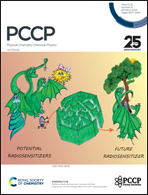Rational control of the typical surface defects of hybrid perovskite using tetrahexylammonium iodide†
Abstract
There are numerous defects existing on the surface and grain boundary of perovskite, which adversely affect the performance and stability of perovskite solar cell devices. Systematic first-principles calculations show that the I vacancy (VI), Pb vacancy (VPb), Pb–I antisite (PbI), and I–Pb antisite (IPb) defects can significantly affect the electronic properties of the surface of formamidinium lead triiodide (FAPbI3); in particular the VPb, PbI and IPb surface defects can introduce defect energy levels in the band gap. Tetrahexylammonium iodide (THAI) that is strongly adsorbed on the (1 0 0) surface of FAPbI3 by forming Pb–I coordination bonds and I⋯H hydrogen bonds could eliminate or reduce the defect states near the band edge or in the band gap by transferring electrons between THAI and the surface of FAPbI3. In particular, the defect states introduced by VPb could be completely eliminated after the adsorption of THAI. This study shows an in-depth understanding of the influence of defects on the electronic properties of the surface of FAPbI3, as well as the passivation mechanism of organic salts on the surface defects of perovskite.



 Please wait while we load your content...
Please wait while we load your content...